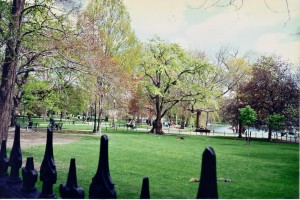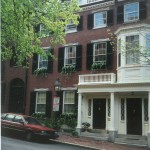Evangeline Adams, a major force in popularizing astrology in the U.S., died in 1932. Once known to millions through her best-selling books and nationally syndicated radio show, she made her name in New York City but was originally from Boston. By visiting the places where she lived, we can travel back in time and get a first-hand glimpse of some of the remnants of this important American astrologer’s life.
If we visit Copley Square, where Adams opened her first astrology studio during her Saturn return in 1896, we can see many remnants of the time. The Boston Public Library immediately catches the eye. Designed by McKim, Mead & White, it was completed in 1895 and would have been bright and new when Evangeline lived there. Across the square lies Trinity Church, known as a masterpiece of Romanesque architecture. Evangeline enjoyed many sermons here, delivered by its first rector, Phillips Brooks. But the church is now a weather-beaten anomaly, dwarfed by the modern high-rises surrounding it. Evangeline’s apartment building, the old Copley Hotel, is gone, now replaced by the ultra-glitzy Westin. We get a sense of what the area might have been like years ago, but the past is effectively lost here.
Evangeline’s previous home was in Beacon Hill, and the walk in that direction brings us closer to a time gone by. The Public Garden, with its wrought-iron fences and Victorian lamps and monuments, looks very much as it must have when Adams lived near here as a young woman. There are no automobiles, the surrounding foliage blots out many of the larger buildings outside, and we can palpably feel some of the graciousness and decorum that we associate with the late 19th century.
As we turn onto Arlington and then Beacon Streets, we’re met with many charming buildings which have been preserved intact for over a century, and are beginning to get a solid feel of how things looked then. When we finally make our way to 40 Chestnut Street, where Evangeline lived before her mother’s death in 1896, we find that the lovely, tree-lined block is the 19th century incarnate. The Adams’ four-story Georgian style townhouse was typical of the upper middle class of the time. Built in the early part of the century, it appears to have been restored to its original condition. Dormers at the top floor probably provided sleeping quarters for Irish servants. A nurse might also have slept above, as Evangeline’s invalid mother from 1893 to 1896 needed constant care. The brass door-knocker, number plate and letter-slot are typical of the period. A boot-scraper is before the column on the right: in an age when horse-drawn travel was the rule, these were quite necessary in order to avoid tacking mud and manure indoors.
The beautiful wrought-iron lamp in front of the house now holds a modern parking sign, but the past is so vitally present and alive here that even cars seem incidental. It’s surprisingly easy to imagine oneself back in the gay ‘nineties. Close your eyes for just a moment, and hear the clip-clop of hooves on the next block. A young, plump woman of middle stature turns the corner, rustling her voluminous floor-length skirts as she goes. Her wavy hair is tied up, but remains a bit awry, and she wears round spectacles. She climbs the steps, opens the front door and disappears into the lighted interior. Who would suppose that the conventional-looking school teacher Evangeline Adams, now inside, is eagerly casting the horoscope of some new acquaintance?
